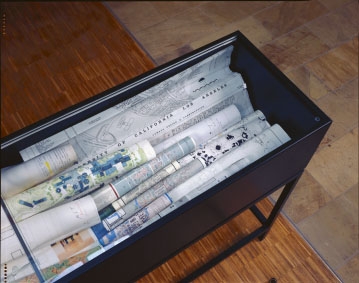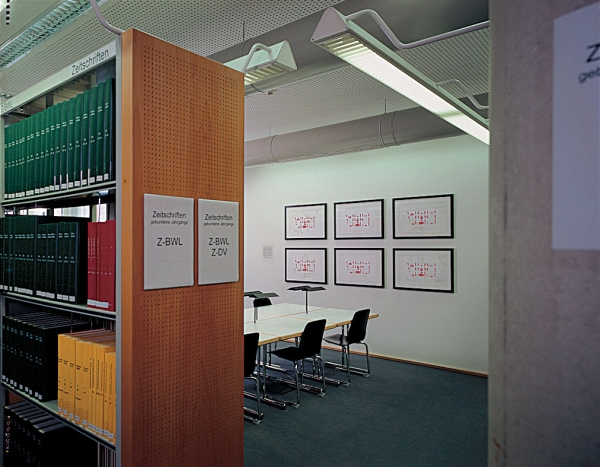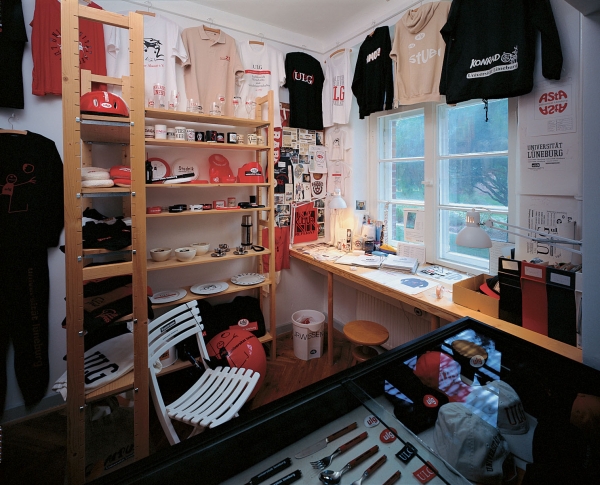Der Campus als Kunstwerk
Since 1998, permanent
Campus of the University Lüneburg, Germany
Entry Hall:
– “Untitled,” 1998, wall text, display case made of steel, glass, building plans; Display case: 44.5 x 20.75 x 122.75 inches
Library:
– “Der Campus als Kunstwerk,” 1998, 101 silkscreens with 16 plaques with text, passe-partout, framed; each 29.5 x 21.7 inches
Computer Center:
– “Abteilung Prototypen” (together with students), 1998, installation: ca. 200 prototypes of merchandising articles in a steel and glass display case and in a wooden bookshelf, desk, stool, lamps, timer, dimensions variable
“Der Campus als Kunstwerk” is a two-part permanent installation conceived by Christian Philipp Müller for the campus of the University of Lüneburg. While the “Abteilung Prototypen” (1996–1998), developed in collaboration with students, focuses on the commercialization of higher education, “Der Campus als Kunstwerk” places the university in its larger geographical context. For Müller, the university’s relocation from the center of town to a spacious campus erected on the site of a former barracks was an opportunity to explore the relationship between its internal forging of an institutional identity and the external pressure on it to be commercially successful. He gave lectures for students in all departments, discussed “built-up art” in the context of university campuses and displayed the label, “Campus University of Lüneburg,” for discussion. The figure, layout, and structure of the new campus were compared with those of a hundred other international campuses. Starting with the plans for the University of Virginia that Thomas Jefferson drew up between 1817 and 1826, Müller himself, together with both students and faculty of the University of Lüneburg, compared the relative position of communal rooms, library, canteen, and other places in which large numbers of people might congregate. Underneath, a quotation from Thomas Jefferson “I like the dreams of the future better than the history of the past” was placed in the foyer of the university library, where a glass case was set up containing the rolled-up plans of comparable universities. The evaluation of these comparisons bore fruit in the form of numerous screen prints, arranged in groups and exhibited at various locations all over the university. The prints show the layout of the reference campus in beige with that of the Lüneburg campus superimposed in red on top. Each of the fifteen series of prints is accompanied by wall texts written by Astrid Wege. Meanwhile, a seminar group, created specifically for this project, was entrusted with the job of drafting fictional corporate identity guidelines and a marketing concept. Here, too, the U.S. concept of a distinctive identity for both the university itself and its students was the central point of reference. Together with the students, Müller also set up a doorless salesroom for branded merchandise in a former porter’s lodge.
Also part of this project at the University of Lüneburg was a publication called “Branding the Campus,” with essays by Beatrice von Bismarck, Ulf Wuggenig, Astrid Wege, and Masao Miyoshi exploring the urban-planning, architectonic, artistic, and educational issues it raises.
[Essay by Alexander Alberro available here.](http://www.christianphilippmueller.ch/index/texts/alberro-alexander/unraveling)




